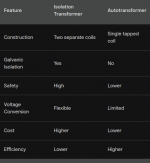ruxton.stanislaw
Senior Member
- Location
- Arkansas
- Occupation
- Laboratory Engineer
Here's a breakdown of isolation transformers, autotransformers, and galvanic separation:
Isolation Transformers:

Choosing between an isolation transformer and an autotransformer depends on your specific needs. If safety and complete electrical isolation are paramount, an isolation transformer is the preferred choice. But if cost, size, and efficiency are primary concerns, and galvanic separation isn't a strict requirement, an autotransformer might be suitable.
Isolation Transformers:
- Function: Provide electrical isolation between the input and output circuits. This means there's no direct current path between the primary and secondary windings.
- Construction: Have two separate coils (windings) made of wire wrapped around a core. The primary winding receives the input voltage, and the secondary winding induces a proportional voltage in the output circuit. There is no electrical connection between the windings, typically separated by insulation materials.
- Benefits:
- Safety: Isolation transformers prevent leakage current from the primary side to the secondary side. This protects users from potential shock hazards if the primary circuit comes into contact with the ground.
- Noise Reduction: They can help reduce electrical noise and ground loops that might interfere with sensitive electronic equipment.
- Voltage Conversion: They can be used to step up or step down voltage levels between the input and output.
- Drawbacks:
- Bulkier and More Expensive: Due to the separate coils, they are generally larger and more expensive than autotransformers.
- Power Loss: There is some energy loss due to the conversion process within the transformer.
- Function: Transfer electrical energy between circuits using a single, tapped coil. A portion of the coil acts as both the primary and secondary winding.
- Construction: Have a single coil with a tap point that determines the voltage output. The input voltage is applied across a portion of the coil, and the output voltage is taken from a different point on the same coil.
- Benefits:
- Simpler and Less Expensive: Their simpler design makes them smaller and less expensive compared to isolation transformers.
- Higher Efficiency: They experience lower energy losses due to the single coil design.
- Drawbacks:
- No Galvanic Isolation: There is a direct electrical connection between the input and output circuits. This means any voltage fluctuations or ground faults on the input side can be present on the output side.
- Limited Voltage Conversion: Their voltage conversion capability is typically limited to boosting or reducing voltage by a certain percentage, not offering the same level of flexibility as isolation transformers.
- Concept: Refers to the complete absence of a direct current path between two circuits. This can be achieved using isolation transformers, but also by other means like optical couplers or pulse transformers.
- Importance: Galvanic separation is crucial for safety reasons and in applications involving sensitive electronics or medical equipment. It prevents leakage currents from causing safety issues, damage or electrical noise interference.

Choosing between an isolation transformer and an autotransformer depends on your specific needs. If safety and complete electrical isolation are paramount, an isolation transformer is the preferred choice. But if cost, size, and efficiency are primary concerns, and galvanic separation isn't a strict requirement, an autotransformer might be suitable.

